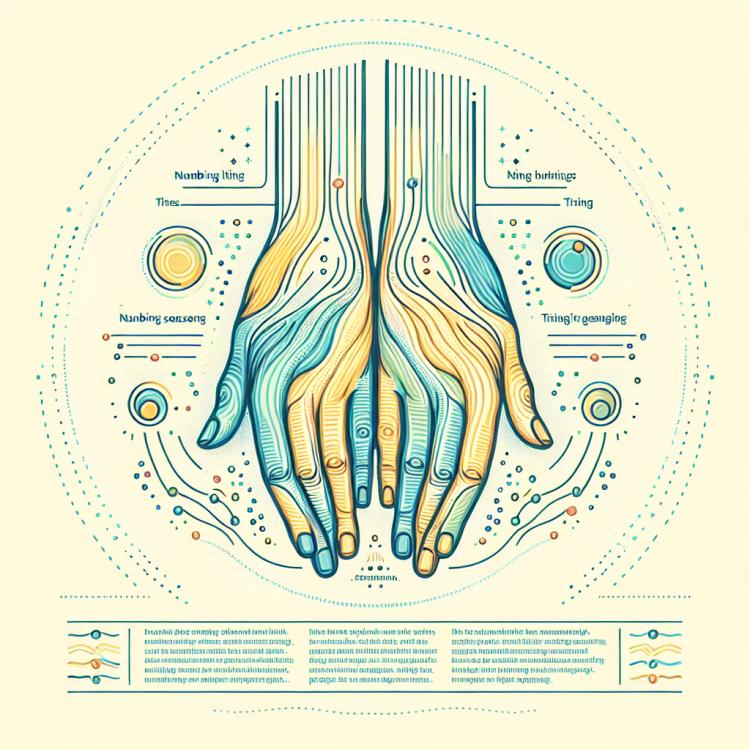
Causes and treatment of tingling in the limbs
About the Symptom
Tingling in the extremities is a common symptom that can affect people of all ages. It may manifest as unusual sensations, such as “pins and needles,” numbness, or a burning feeling. Typically, this condition occurs in the hands, legs, fingers, and feet, and can be caused by various factors. The causes of tingling can range from temporary ones, such as an uncomfortable body position, to more serious conditions, including diabetes, neurological disorders, or circulatory issues.
It is important to note that tingling in the extremities may not only be a temporary discomfort. In some cases, it can indicate the presence of conditions that require medical attention. For example, with diabetes, tingling may be related to diabetic neuropathy, and with circulatory disorders, such a condition may signal the need for urgent medical intervention. Therefore, if tingling sensations are regular or intense, it is advisable to seek a medical clinic for diagnosis and appropriate treatment.
Diseases
Tingling in the extremities, or paresthesia, can be a symptom of various diseases and conditions that affect the nervous system or circulation. Typically, this symptom arises from external factors such as pressure on the nerves, but if it becomes frequent or persistent, it may indicate serious health issues. It is important to remember that the symptom itself is not a diagnosis, so it is essential to consult a specialist for diagnosis and identification of the underlying problem.
There are many diseases that can cause tingling in the extremities. Below is a list of the most common ones:
- Diabetic neuropathy
- Nerve entrapment syndrome
- Multiple sclerosis
- Stroke or transient ischemic attack (TIA)
- Cervical osteochondrosis
- Peripheral neuropathy
- Hypervitaminosis or deficiency of vitamin B group
- Autoimmune diseases (e.g., lupus)
- Spine or neck injuries
- Alcohol dependence
Despite the wide range of possible causes, for an accurate diagnosis and treatment, be sure to consult a doctor. They will be able to perform the necessary examinations and prescribe appropriate therapy to eliminate the tingling and prevent its recurrence.
Diagnosis
The diagnosis of tingling in the extremities is an important step in determining the cause of this symptom. The doctor first conducts a detailed medical history, clarifying when the symptoms appeared, what factors may have triggered them, and whether there are any accompanying diseases. Based on the information obtained, additional tests may be ordered to clarify the diagnosis.
Among the diagnostic methods, non-invasive studies such as magnetic resonance imaging (MRI) and computed tomography (CT) are of primary importance, as they allow visualization of the condition of soft tissues and the nervous system. Electromyography (EMG) and electroencephalography (EEG) may also be recommended to assess the functional state of the nerves and the conductivity of electrical impulses. These methods help the doctor determine the presence or absence of diseases that cause tingling in the extremities.
- Complete blood count
- Biochemical blood analysis
- Magnetic resonance imaging (MRI)
- Computed tomography (CT)
- Electromyography (EMG)
- Electroneuromyography (ENMG)
- Ultrasound examination (US) of vessels
Which doctor to consult
If you are experiencing tingling in your limbs, it is important not to ignore this symptom and to seek medical help. Tingling can be a manifestation of various diseases, and only a qualified doctor will be able to conduct a correct diagnosis and prescribe appropriate treatment. Considering the variety of causes that can lead to a tingling sensation, you may need to consult several specialists.
First of all, it is advisable to visit a therapist who can assess your overall condition and refer you to narrow specialists depending on your symptoms. It is also possible that you will need a consultation with a neurologist, who specializes in nervous system diseases, or an orthopedist if the problem is related to the musculoskeletal system. In some cases, you may need to see an endocrinologist, gastroenterologist, or vascular surgeon if the tingling is associated with metabolic disorders or the vascular system.
- Therapist
- Neurologist
- Orthopedist
- Endocrinologist
- Gastroenterologist
- Vascular surgeon
Types of Tingling in the Limbs
Tingling in the limbs can manifest in different forms and have various causes. The sensations can range from a mild tingling feeling to severe pain and discomfort. It is important to understand that the nature of the tingling can indicate different conditions and diseases. For example, tingling may be temporary and occur when you have been in one position for a long time, or it can be chronic, signaling serious medical issues.
There are several types of tingling that can be classified according to various criteria. One such criterion is localization: tingling can be felt in the hands, legs, fingers, or in both limbs simultaneously. Another important aspect is duration: tingling can be episodic or constant. Understanding the characteristics of tingling can help doctors diagnose the cause of the symptom more accurately and prescribe appropriate treatment.
- Episodic tingling
- Chronic tingling
- Tingling in one limb
- Tingling in both limbs
- Tingling in the fingers of the hands or feet
- Tingling accompanied by pain or swelling
Causes of Tingling in the Extremities
Tingling in the extremities, also known as paresthesia, can be caused by a variety of factors related to both physiological and pathological conditions. One of the most common causes of tingling is nerve compression, which can occur from prolonged positioning or due to friction. In such cases, tingling is usually temporary and resolves as soon as the body position is changed.
However, if tingling becomes persistent or occurs regularly, it may indicate more serious health issues. For example, neurological diseases such as multiple sclerosis or neuropathy can cause such sensations. Additionally, diabetes, stroke, and other microcirculation disorders can also be factors leading to tingling in the hands and feet.
- Nerve compression (carpal tunnel syndrome)
- Diabetic neuropathy
- Stroke or TIA (transient ischemic attack)
- Multiple sclerosis
- Vitamin deficiencies (especially B12)
- Alcohol intoxication
- Autoimmune diseases
Common Related Pathologies
Tingling in the limbs can often be a symptom of more serious diseases or pathologies that require careful examination. Among the most common related pathologies is diabetic neuropathy, which occurs in patients with type 2 diabetes. This disease leads to nerve damage, causing loss of sensation, tingling, and even pain in the limbs.
Another important cause of tingling can be carpal tunnel syndrome, associated with the narrowing of the space through which nerves and tendons pass in the wrist. This can also cause burning and numbness in the hands, especially with prolonged computer work. Other pathologies, such as multiple sclerosis and cervical osteochondrosis, can also manifest as tingling in the limbs, necessitating a comprehensive approach to diagnosis and treatment.
- Diabetic neuropathy
- Carpal tunnel syndrome
- Multiple sclerosis
- Cervical osteochondrosis
- Peripheral neuropathy
- Stroke
- Non-Hodgkin lymphoma
Expert Opinion
Tingling in the extremities is a symptom that can indicate a wide range of diseases and conditions, from minor to serious. It is important to understand that although this symptom can often arise from temporary nerve compression, it can also signal more serious disruptions in the body. Misdiagnosis can lead to further complications, so it is advisable to consult specialists when this symptom occurs.
According to medical experts, tingling in the extremities requires a comprehensive approach to diagnosis and treatment. Depending on accompanying symptoms, such as weakness, numbness, or pain, consultations with various specialists, including neurologists and endocrinologists, may be necessary. It is also important to monitor one’s lifestyle, particularly physical activity, nutrition, and overall health status, as these factors can significantly influence the onset or worsening of tingling in the extremities.

Treatment of Tingling in the Limbs
Tingling in the limbs can be a result of various pathologies, and the approach to its treatment should be based on accurate diagnosis and understanding of the cause of the symptom. It is important to note that, in order to eliminate tingling, it is essential to identify and treat the underlying disease first. Treatment may include medication therapy, physiotherapy, and in some cases, surgical intervention.
Medication treatment may include non-steroidal anti-inflammatory drugs, analgesics, and medications that help improve blood circulation. Physiotherapeutic procedures, such as massage, electrical stimulation, or therapeutic exercise, can help restore limb function and reduce tingling. It is also important to consider lifestyle changes, which may include proper nutrition, physical activity, and quitting bad habits.
Additionally, if tingling is related to nervous system disorders, neuroprotectors or agents that improve nerve conductance may be recommended. The specific treatment plan depends on the individual characteristics of the patient and the severity of the condition. Therefore, consulting a qualified specialist is a necessary step in obtaining effective assistance for tingling in the limbs.
- Medication therapy
- Physiotherapeutic procedures
- Lifestyle changes
- Surgical intervention (if necessary)
- Consultations with specialized specialists
Complications
Tingling in the limbs can be not only a temporary discomfort but also a sign of more serious diseases. If this symptom is not given due attention, various complications may arise that significantly worsen the patient’s quality of life. One of the most common consequences is the development of chronic pain, which can hinder the performance of daily tasks and reduce overall productivity.
Moreover, irregular or insufficient investigation of the cause of tingling can lead to the progression of the underlying disease. For example, if tingling is a result of diabetic neuropathy, loss of sensitivity in the limbs may occur, increasing the risk of injuries and accidents. Heart or vascular diseases can also lead to serious health problems, such as stroke or heart attack, if they are not diagnosed and treated in time.
It is important to understand that ignoring symptoms and the absence of adequate treatment can lead to the following complications:
- Increased pain syndrome.
- Loss of sensitivity in the limbs.
- Development of chronic diseases (e.g., diabetic neuropathy).
- Risk of trauma due to loss of sensitivity.
- Psychological disorders related to chronic discomfort.